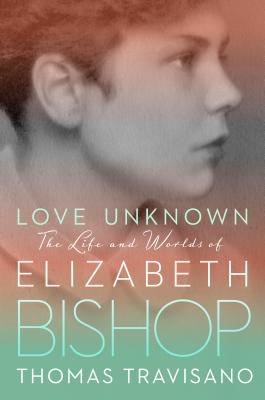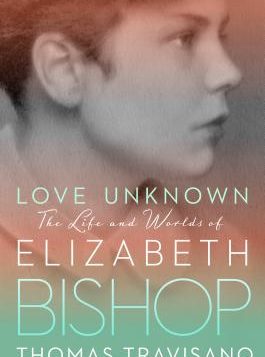 Love Unknown: The Life and Worlds of Elizabeth Bishop
Love Unknown: The Life and Worlds of Elizabeth Bishop
by Thomas Travisano
Viking. 432 pages, $32.
THIS BIOGRAPHY opens with the inviting claim that “Elizabeth Bishop’s life is a great story,” and Thomas Travisano supports it with a neatly woven tapestry of circumstances, human relationships, and art that defined the poet’s days from 1911 to 1979. Travisano is president and founder of the international Elizabeth Bishop Society and principal editor of Words in Air, the collected correspondence between Bishop and Robert Lowell.
Love Unknown considers Bishop’s poetry and prose, letters (including to her physician and psychotherapist), archival material, and prior scholarship. Among Bishop biographies, Travisano’s stands out as comprehensive and up-to-date, incorporating recent interviews with Bishop’s protégé Frank Bidart, with her onetime lover Roxanne Cumming, and with Monica Stearns Morse, adoptive daughter of Mary Morse, a neighbor and friend in Brazil. More importantly, without ignoring Bishop’s suffering, Travisano puts refreshing emphasis on her success in building a whole life. He highlights what kept Bishop going. Using George Herbert’s poem “Love Unknown” (a Bishop favorite) as framework, he describes how facing and surmounting harsh challenges spurred Bishop’s insights, creativity, and connections with others.
The author has called Bishop’s writing “pervasively autobiographical,” and throughout Love Unknown he illustrates how she used experience as catalyst for her art. For example, “The Moose,” a narrative poem composed for Harvard’s 1972 Phi Beta Kappa ceremony, evokes “reassuring presences” in the poet’s bereaved childhood, while the stunning villanelle, “One Art,” dramatizes her fear of losing a partner’s love.
The biography is organized chronologically. Vivid chapters depict Bishop’s infancy with well-to-do parents in Worcester, Massachusetts; her early childhood with maternal grandparents in Great Village, Nova Scotia; and eight years in Revere and Saugus, Massachusetts, with relatives who were paid for her care.
Bishop knew from childhood what she liked, and she acted on it. When barely a teen at sailing camp, for instance, she met her first girlfriend and wrote the first of her poems to be published. By the time she entered Walnut Hill, a boarding high school in Natick, Mass., Bishop knew that she loved women. When an aunt with whom she was staying in the Berkshires one summer insisted on organizing a party for her with boys, Elizabeth refused to attend—and hitchhiked back to school. Finding the night doors locked, she slept outside.
 The fledgling poet was defiant, well read, and popular, already an intellectual. “We … spoke of her as ‘the Bishop,’ and we all knew … she was a genius,” commented a Walnut Hill classmate sixty-odd years later. The writer also took time for reflection when needed. Vacationing in Wellfleet after her freshman year at Vassar, Bishop was unsure about going back. On impulse, she set off alone for Provincetown, a distance of 23 miles. “I walked … with a thermos bottle of black tea, a ham sandwich, a tooth brush & comb, & a mouthorgan,” she later wrote to a friend. It was “wonderful along there in the middle of the night—the sky, stars and the water and sand all phosphorous. I went in my bare feet most of the time and stopped for a swim occasionally.”
The fledgling poet was defiant, well read, and popular, already an intellectual. “We … spoke of her as ‘the Bishop,’ and we all knew … she was a genius,” commented a Walnut Hill classmate sixty-odd years later. The writer also took time for reflection when needed. Vacationing in Wellfleet after her freshman year at Vassar, Bishop was unsure about going back. On impulse, she set off alone for Provincetown, a distance of 23 miles. “I walked … with a thermos bottle of black tea, a ham sandwich, a tooth brush & comb, & a mouthorgan,” she later wrote to a friend. It was “wonderful along there in the middle of the night—the sky, stars and the water and sand all phosphorous. I went in my bare feet most of the time and stopped for a swim occasionally.”
Surprisingly, the poet spoke of herself as someone who waited for things to happen, but Travisano sees her as an initiator who wrote prize-winning poetry without neglecting friendship or love. Bishop declared at an early age that she would be “no man’s wife.” Travisano thinks sexual abuse she endured from an uncle may have increased her general distrust of men, yet her mother’s father was the poet’s “favorite relative” and she developed close friendships with many men in the arts. Besides Lowell, these included gay poets such as John Malcolm Brinnin, James Merrill, Thom Gunn, and Bidart himself, who would become her literary co-executor.
Bishop befriended women poets as well, such as Marianne Moore and May Swenson. However, her longest intimate relationships were with three nonliterary women, each a confidant and protector at different times: Marjorie Stevens, who lived with Bishop in Key West during the 1940s; Lota de Macedo Soares, with whom she shared fifteen productive, largely happy years in Rio de Janeiro; and Alice Methfessel, her partner in Boston for the last seven years of her life. Unlike Megan Marshall in A Miracle for Breakfast or Carmen Oliveira in Rare and Commonplace Flowers, Travisano does not probe the drama in Bishop’s closest relationships, but he recounts more than a dozen lesser flirtations—such as her affair with Lilli Correira, who comforted her in the course of a devastating breakup with Lota.
Outside of her relationships, there was also turbulence in her life caused by asthma, depression, and drinking, among other things. Travisano is empathetic, praising her discipline in seeking medical help and accepting unpleasant treatments, like steroid injections or anti-addiction drugs. He notes that the patient also cultivated her own cures, finding relief in writing, travel, painting, and baking.
The poet had wanted her tombstone to be inscribed with the words “Awful but cheerful” from her poem “The Bight,” but after she died Methfessel worried that the words were too stark. With the stone still blank a year later, Travisano suggested adding a prior line from the same poem for context. This was done, to read: “All the untidy activity continues,/ Awful but cheerful.” Reading Love Unknown is like touring Bishop’s word-ridden, complex, and stirring worlds. With an atlas and a book of her poems close by, it delivers a highly satisfying ride.
Rosemary Booth is a writer and photographer living in Cambridge, Massachusetts.






